Picture this: A nuclear alarm goes off, and everyone’s talking about bunkers. But what if you don’t have one? Is there still a chance? How do you survive a nuclear war without a bunker?
To survive a nuclear war without a bunker is about quick thinking, finding safe spots, grabbing vital supplies, and adjusting as things unfold. Knowledge and a game plan are key.
Feeling a bit on edge thinking about how to survive a nuclear war without a bunker? You’re not alone. Let’s dive deep into this guide where we break things down step by step, making the unimaginable a tad more manageable.
Quick Links
- Understanding a Nuclear Attack’s Threat
- How to Identify an Incoming Nuclear Threat
- Understanding Vital Supplies and Storage
- Communication and Staying Informed
- Navigating the Post-Blast Landscape
- Mental and Physical Wellbeing
Understanding a Nuclear Attack’s Threat
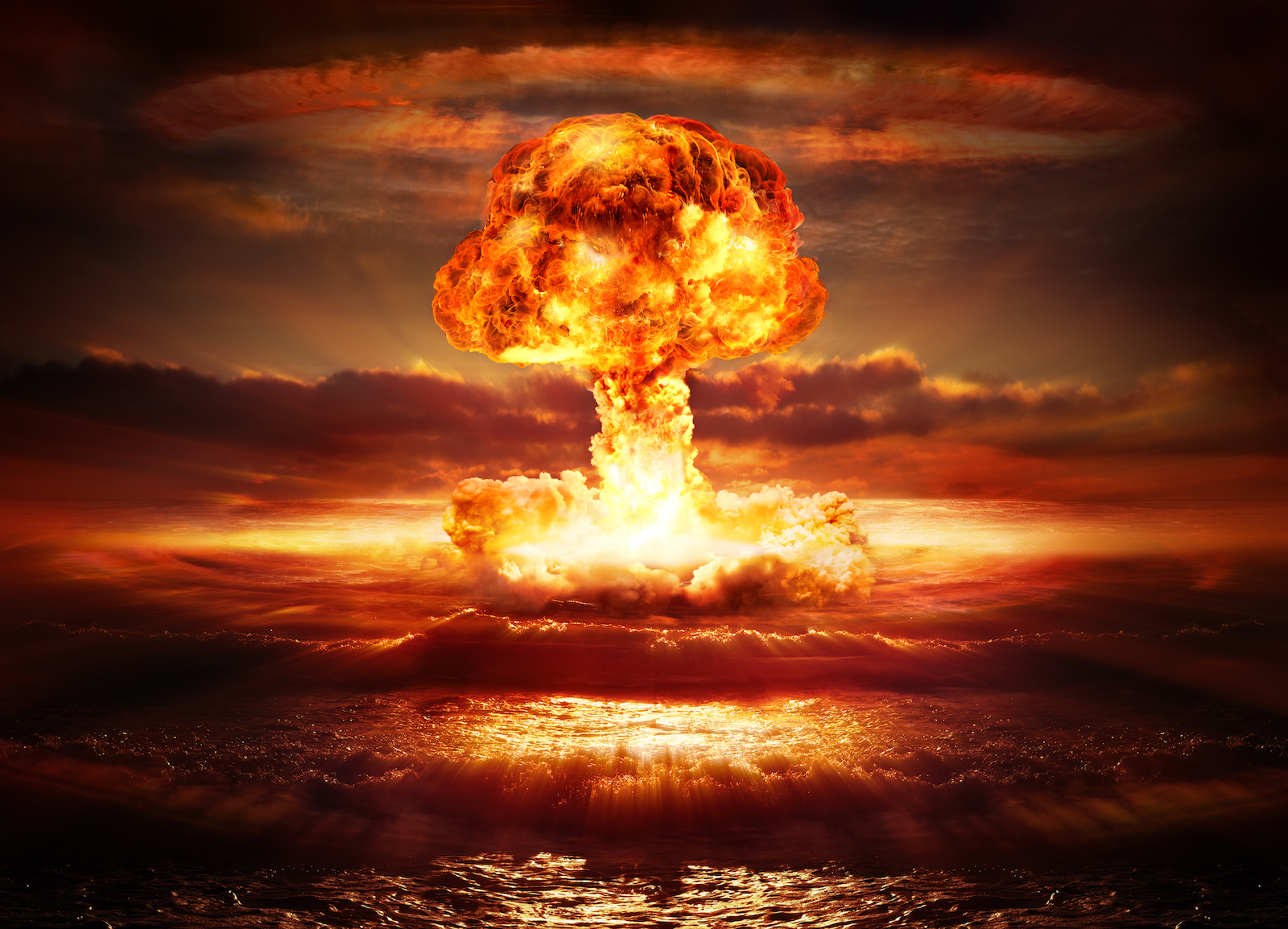
Let’s break it down first. What are we really facing when we talk about a nuclear attack? There’s the massive explosion, an overwhelming burst of heat, and an impending shockwave.
Now, while that sounds menacing, there’s something even more sinister that follows: the fallout. Radioactive particles scatter, risking contamination of air, soil, and water sources for miles. Knowing this makes your next steps clearer and more urgent.
Preparation means understanding. And with a nuclear threat, it’s not just about what happens during the explosion but what comes after.
Fallout can linger, turning every corner into a potential hazard. That’s why grasping the full scope of this risk is your starting point to effective survival.
This isn’t just hypothetical stuff. With geopolitical tensions, knowing these risks isn’t just for the movies anymore. It’s about being informed, proactive, and ultimately ensuring your safety in unpredictable situations.
Importance of Preparedness: Why Every Second and Action Counts
Picture this: alarms blare out, announcing a nuclear threat. Your heart races, your mind whirls. What do you do? Well, preparedness is more than just having supplies on hand. It’s having a game plan, knowing where to go, and acting decisively.
Think back to school fire drills. Everyone knew their roles, where to exit, and how to stay safe. That’s how your nuclear preparedness should be: rehearsed, clear, and efficient.
Being mentally ready, having routes in mind, and understanding the dos and don’ts can make all the difference between chaos and structured survival.
It’s more than just stockpiling. It’s about adapting, being in the know, and ensuring every action is a step toward safety. Because when every second counts, your prior knowledge is the ace up your sleeve.
How to Identify an Incoming Nuclear Threat
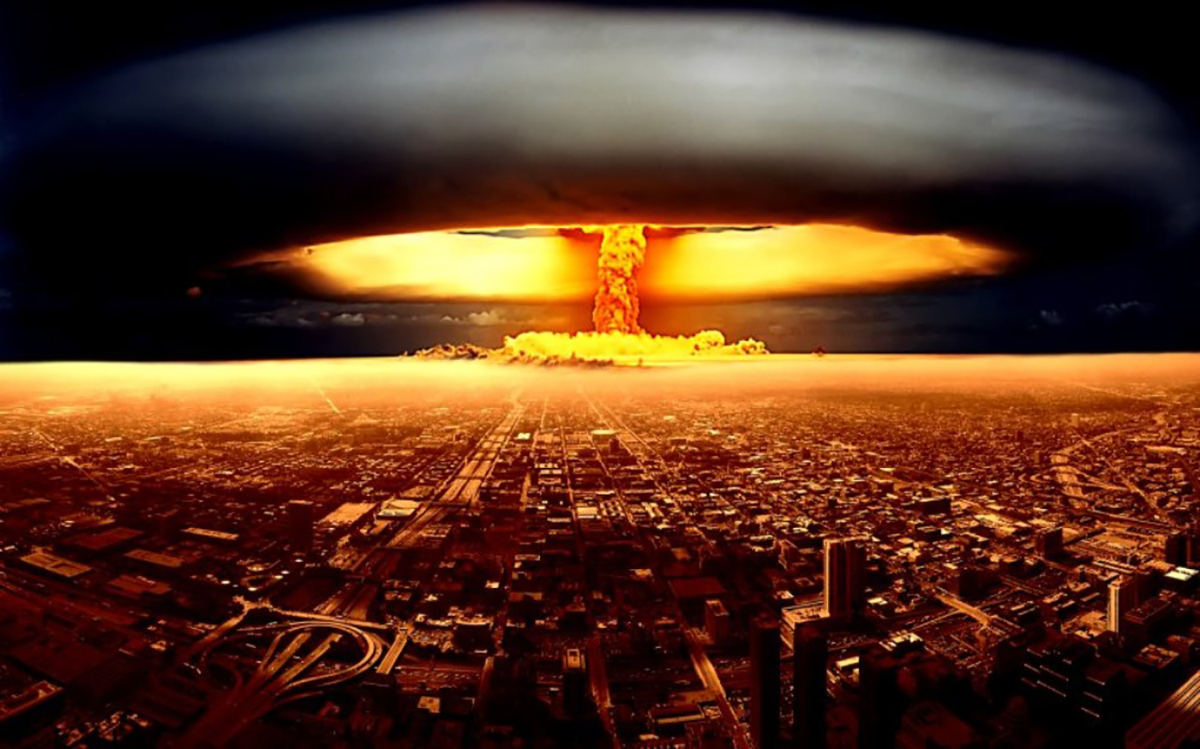
Identifying an incoming nuclear threat is a sophisticated process that involves several interconnected steps. Initially, satellite monitoring plays a crucial role.
Countries use satellites equipped with infrared sensors that can detect the heat signature of a missile launch almost instantly.
Following this detection, radar systems come into play. These systems track the trajectory of the missile, providing vital information about its path and potential target.
Simultaneously, intelligence agencies work to analyze the situation, often relying on a network of informants, electronic surveillance, and historical data to determine the intent and capability of the potential threat.
This information is crucial in assessing whether the launch is a test, a bluff, or an actual attack.
Furthermore, ground-based monitoring stations and naval ships equipped with advanced tracking technology also contribute to this detection network. These stations can offer additional data points to triangulate the missile’s path more accurately.
In the event of a confirmed threat, emergency communication systems are activated. This includes notifying top government officials, military leaders, and, if necessary, the public.
The decision on how to respond is typically made at the highest levels of government, often in consultation with allied nations and military advisors.
Finally, international cooperation and treaties play a significant role in nuclear threat reduction. Organizations like the United Nations and treaties such as the Nuclear Non-Proliferation Treaty (NPT) aim to prevent the spread of nuclear weapons and reduce the likelihood of nuclear conflict.
Diplomatic channels are often used to de-escalate potential threats and resolve conflicts that could lead to nuclear escalation.
For preppers, here’s what you should look out for when it comes to nuclear wars:
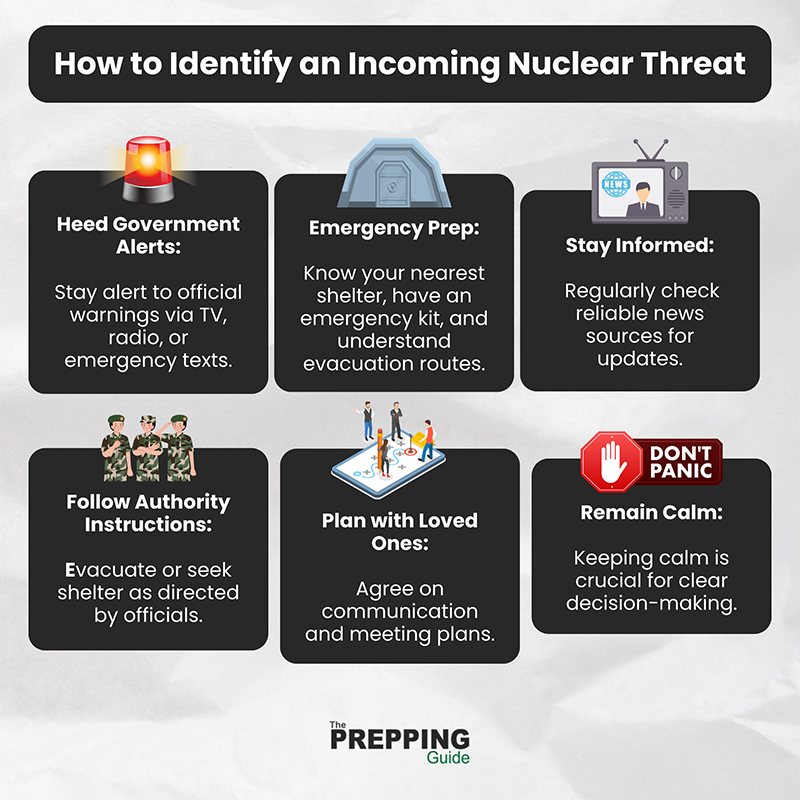
Finding the Safest Place in Your Current Location
In the event of a nuclear war, finding the safest place in your current location is a matter of utmost urgency to minimize the risk from the blast, heat, and radioactive fallout.
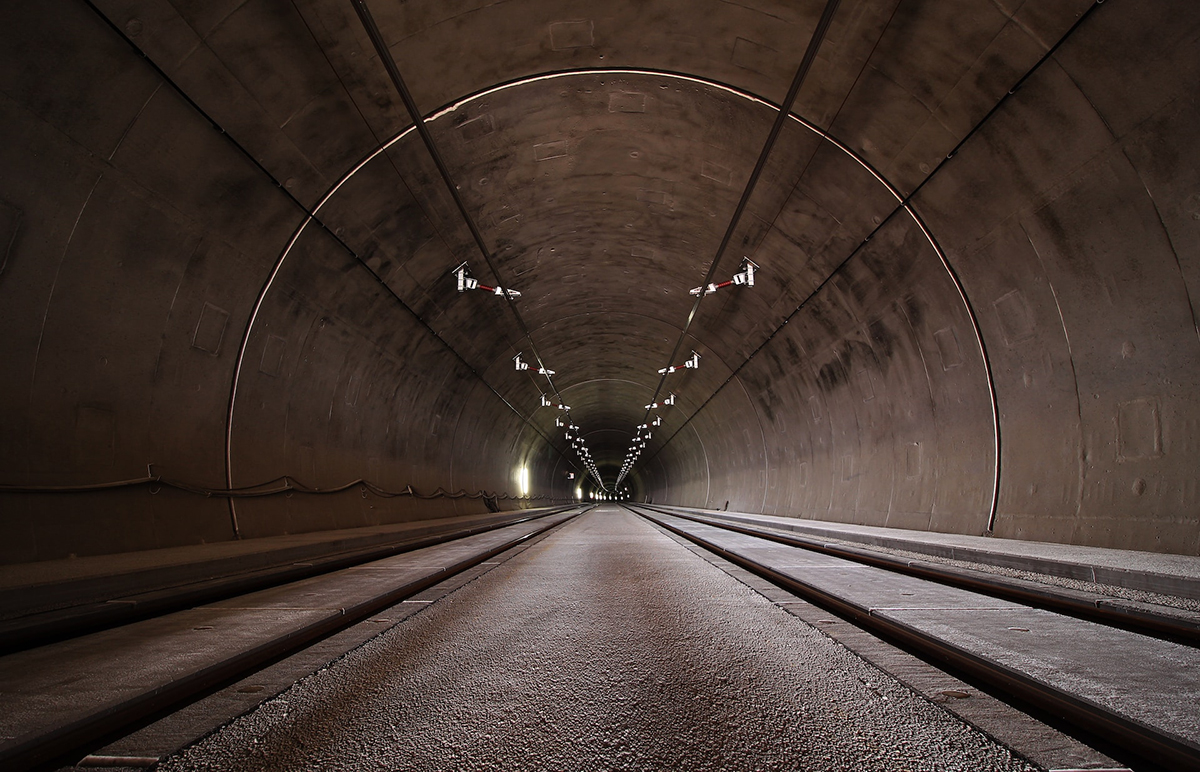
Ideally, the best protection you can find is an underground shelter, such as a basement, bunker, or subway, which can provide significant shielding.
If an underground bunker is not available during a nuclear war, your next best choice to survive is a solid building, preferably made of concrete or brick. Inside, you want to put as many walls and barriers between you and the outside as possible.
The central areas of a building, away from windows and exterior walls, offer the most protection.
It’s also important to stay inside for at least 24 hours after a blast to avoid the initial radioactive fallout, which is most dangerous in the first few hours. During this time, seal any gaps in doors or windows to prevent radioactive particles from entering.
Keep in mind that these are immediate actions to take during a nuclear event. Long-term safety would depend on following official guidance, which may include evacuation orders or other emergency measures.
The key is to stay informed through reliable sources of information and follow the instructions of emergency services and authorities.
How To Do A Makeshift Shelter
Creating a makeshift shelter or bunker to survive a nuclear war is vital for protection against blast effects and radioactive fallout.
Here are steps to set up a basic shelter:
1. Choose the Right Location: Find the most protected space in your current setting. An underground area, like a basement, is ideal. If that’s not available, choose an interior room without windows, preferably in the middle of the building.
If you’re at home, here’s how you can find the safest spot in your house during a nuclear war:
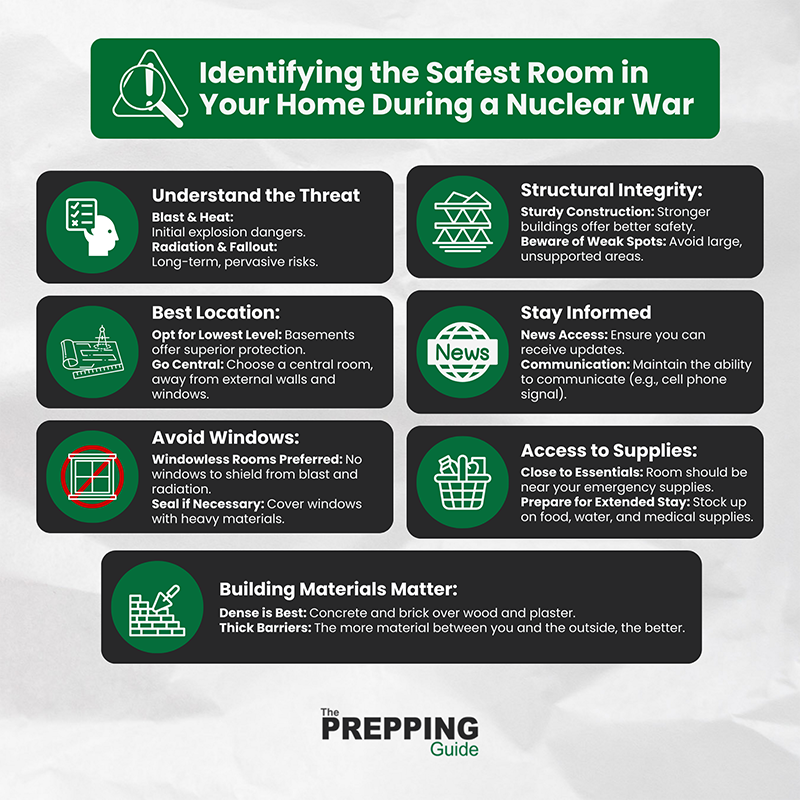
2. Improvise with Materials: Use heavy furniture, mattresses, and books to create denser walls and barriers. Pile them against windows and doors to add an extra layer of protection against fallout.
3. Seal Off Areas: Close all windows and doors. Use plastic sheeting, duct tape, or even thick blankets to seal any gaps, minimizing the entry of radioactive particles.
4. Create a Safe Zone: Inside your chosen room or area, create a space where you can stay for an extended period. Bring in water, non-perishable food, a first aid kit, a battery-powered radio for updates, and other essentials.
5. Stay Put and Informed: After a nuclear blast, the most dangerous fallout radiation usually occurs in the first 24-48 hours. Stay in your shelter during this time and listen to the radio for official news and instructions.
Understanding Vital Supplies and Storage
Now, let’s talk about supplies. You’ve shielded yourself from immediate danger, but survival is a marathon, not a sprint.
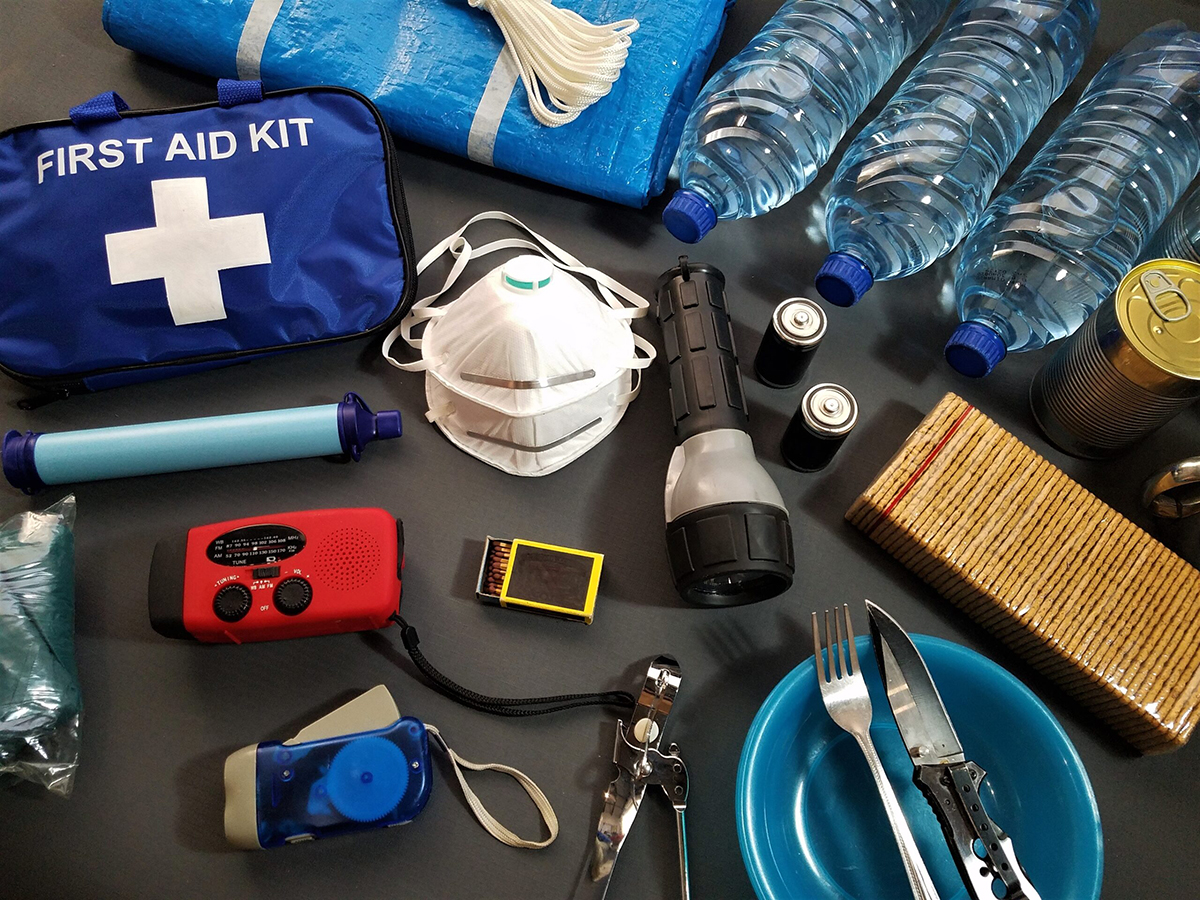
It’s all about long-term strategy, and a significant part of that is ensuring you have the essentials on hand. But what are these essentials, and how do you make them last?
Water: Sourcing, Storing, and Purifying for Safe Consumption
Water – it’s the essence of life, especially in a post-nuclear situation. Ideally, you should store a two-week supply for each person.
But sometimes, ideal isn’t our reality. If you need to source water post-blast, avoid rain or puddles immediately after the explosion as they can be radioactive.
Once you’ve got water, it’s purification time. Boiling is your best friend. Bring water to a rolling boil for at least a minute, then let it cool. If you’ve got them, water purification tablets or filters can be a boon. They’re lightweight, easy to use, and effective.
If you’re unsure how to purify water to make them safe to consume, you can refer to the guide below:
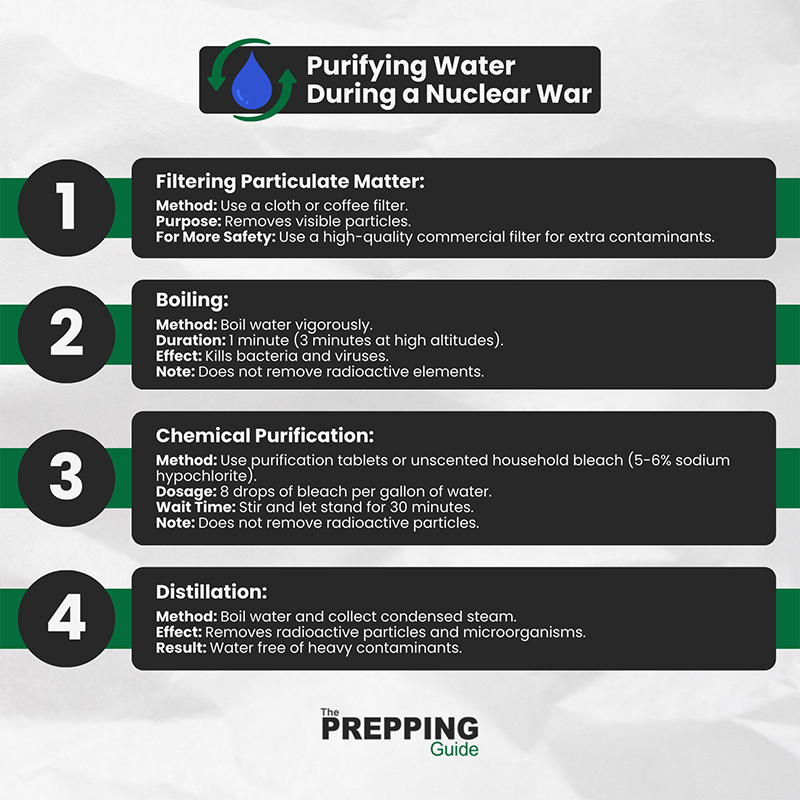
In terms of storage, keep water in sealed, uncontaminated containers. Rotate your stock, using and replacing to ensure freshness. And always, always prioritize water. Your survival literally depends on it.
Food Essentials: Best Non-perishables and Storage Techniques
Alright, food time. Focus on sustenance. Think non-perishables: canned goods, grains, and freeze-dried foods. These items have a longer shelf life and provide essential nutrients.
Store food in a cool, dry place, away from direct sunlight or contaminants. Using sealed containers or vacuum-sealed bags prevents spoilage and keeps pests at bay.
And remember, when in doubt, trust your senses. If it smells or looks off, it’s better to err on the side of caution.
Rotate your food stock just like water. Consume older items first and replace them with fresh ones. This keeps your food supply fresh and nutritious. The goal? Stay fueled and healthy amidst the chaos.
Medical Must-haves: First Aid, Iodine Tablets, and Radiation Sickness Management
Now, onto medical supplies. A well-stocked first aid kit is crucial. Bandages, antiseptics, pain relievers – the basics can make a big difference when medical help isn’t immediately available. But in a nuclear situation, there are a few additional essentials.
Iodine tablets are a game-changer. They protect your thyroid from absorbing radioactive iodine. But remember, they’re not a one-stop solution, so pair them with other protective measures.
And let’s touch on radiation sickness. Symptoms can range from nausea to fatigue. Having anti-nausea medicine on hand can help manage these symptoms.
But here’s the thing: prevention is better than cure. Shielding, decontamination, and limiting exposure remain your primary defense strategies. The goal is to be prepared, stay informed, and act decisively when the need arises.
Communication and Staying Informed
You’ve got shelter and supplies in check, but here’s the deal: isolation isn’t ideal in post-nuclear scenarios. Staying connected to the world around you is pivotal.
Knowledge is power, and in this situation, it might just be the difference between life and death. So, let’s talk tools, tunes, and touching base.
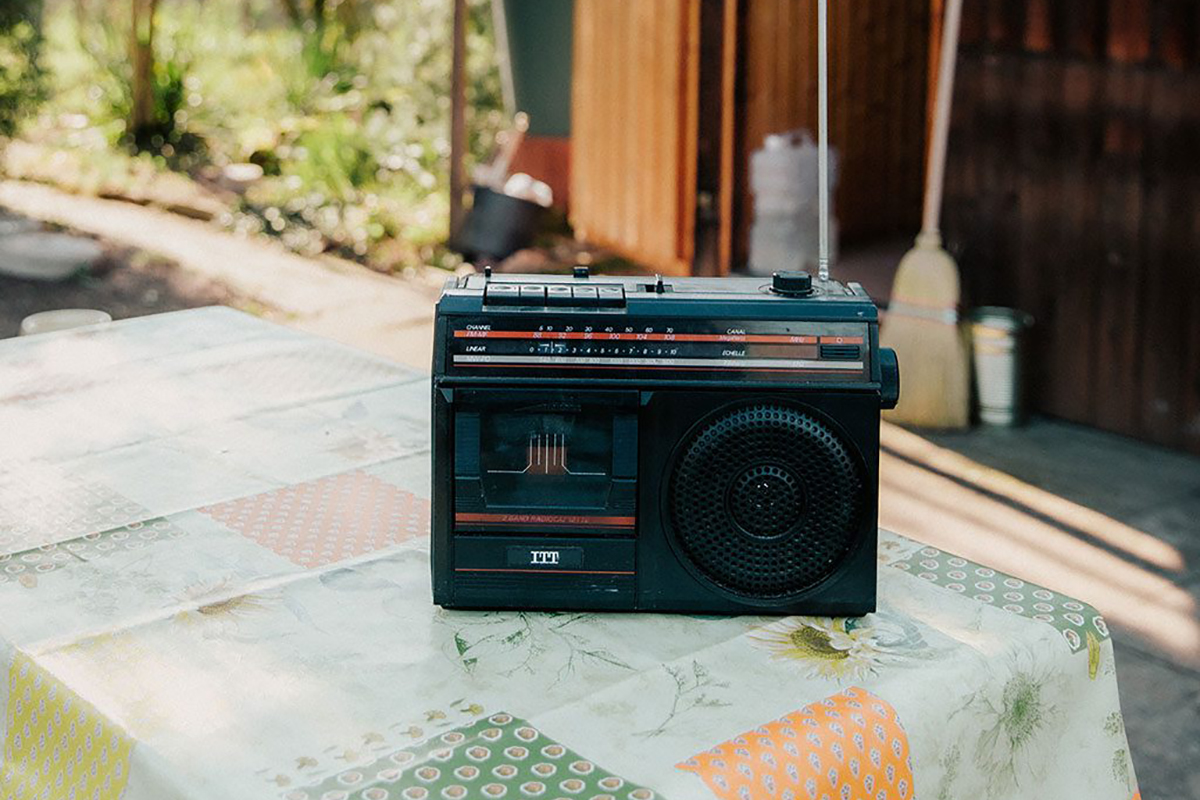
Radios? They’re golden in times like these. Battery-operated or hand-crank, a radio keeps you looped in on vital broadcasts and alerts.
Regularly tune in to designated emergency channels. Keep spare batteries, and if possible, invest in a multi-powered radio.
Now, sending out signals is equally essential. Flares, mirrors, or even DIY Morse code with flashlights can communicate distress or your location.
If you’re tech-savvy and power permits, satellite phones or ham radios can be instrumental. Keep them shielded, though; electromagnetic pulses from nuclear blasts can fry electronics.
Reaching Out: Establishing Contact with Nearby Survivors
Survival isn’t just a solo game. There’s strength in numbers. Making contact with neighbors or nearby survivors can pool resources, skills, and manpower.
Simple shouts, knocking sequences, or light signals can help you find others without venturing out unnecessarily.
Grouping up can provide emotional support in trying times, too. But always approach new contacts with caution. Trust but verify. Share resources, knowledge, and establish protocols. A united front stands a better chance against the odds.
Navigating the Post-Blast Landscape
Emerging post-blast isn’t just about flinging open the doors and stepping out. The landscape you once knew is transformed, with new challenges and hazards.
This new world requires a keen sense of awareness, smart navigation, and collaboration. Strap in, it’s about to get exploratory.
Assessing the Situation: Identifying Safe and Dangerous Zones
Before venturing out, get the lay of the land. Use any available tools, like maps or satellite imagery, to pinpoint potential fallout zones. These are the no-go areas. Look for green zones, places less affected by the blast.
Weather patterns play a role, too. Rain, for instance, can spread radiation, creating hotspots. Cloudy or windy days can displace fallout, altering safe zones. Stay informed, plan your routes carefully, and when in doubt, stick to your shelter.
How to Travel Safely in a Radioactive Environment
When it’s time to move, prep is paramount. Wear protective clothing, covering as much skin as possible. Gas masks, goggles, and gloves? Non-negotiables. Every barrier between you and the environment decreases contamination risks.
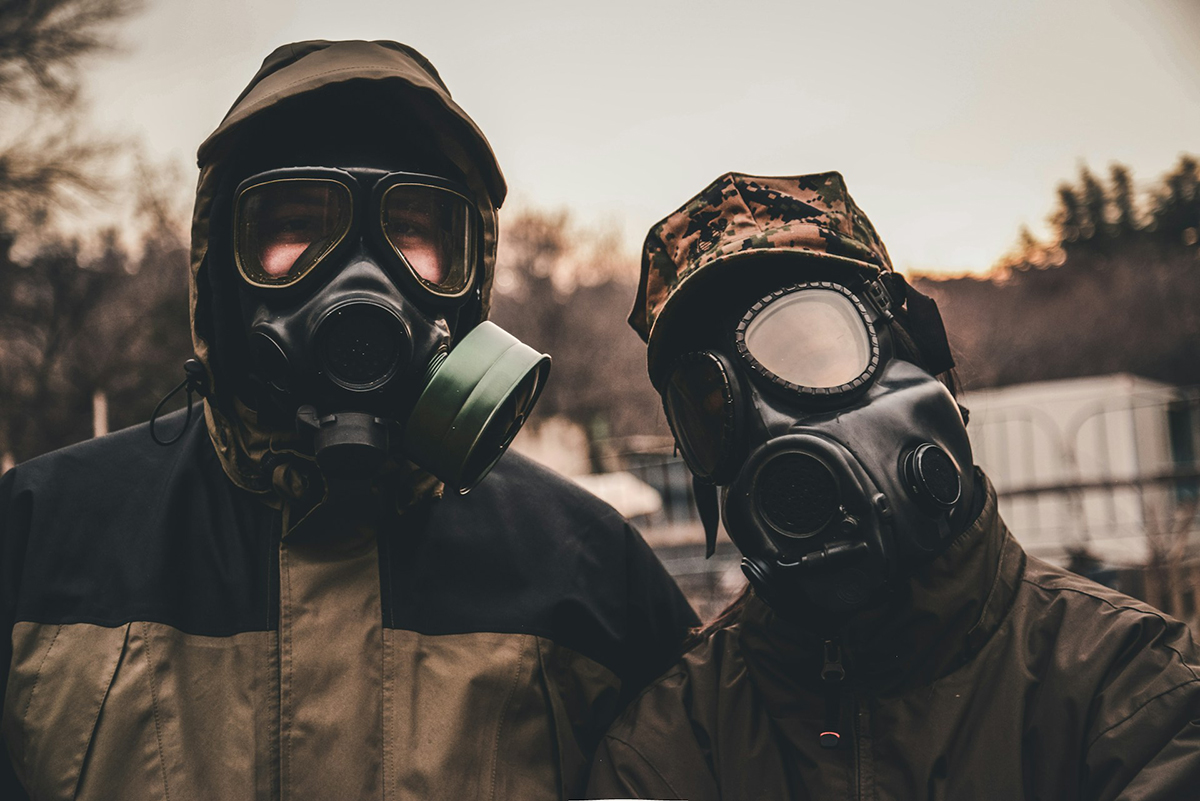
Travel during daylight, and if possible, stick to clear paths. Avoiding dusty areas or puddles minimizes contact with potential fallout.
Remember, speed is of the essence. Limit outdoor time, move efficiently, and always be on the lookout for safer ground.
Connecting with Others for Greater Survival Chances
In a transformed world, community is your cornerstone. Beyond immediate survival, humans thrive on connection and collaboration.
Pool resources, share tasks, and establish routines. Creating a sense of normalcy amidst chaos aids mental wellbeing.
Establish roles within your group. Some can scout, others can handle food and water, while a few can be on guard duty. Trust and open communication are foundational.
By banding together, rebuilding, and restoring hope, the journey from mere survival to thriving truly begins.
Mental and Physical Wellbeing
So, you’ve tackled logistics, supplies, and navigation. But, here’s the kicker: to survive a nuclear war isn’t just about finding an underground bunker or external challenges. Your mind and body need equal attention.
In the harshest times, resilience is both a mental and physical game. Let’s dive into your wellbeing playbook.
Coping Mechanisms: Handling Stress and Trauma in Crisis
The mental aftermath of a nuclear event can be overwhelming. You might experience stress, anxiety, and a rollercoaster of emotions.
Recognizing these feelings is the first step. Journaling or talking can offer an outlet, helping you process events and emotions.
Distraction techniques, like counting, deep breathing, or visualization, can be incredibly grounding. It’s about rerouting the brain’s focus. Even in the bleakest moments, try to find small moments of gratitude or positivity.
Over time, these coping mechanisms can help manage stress levels and foster resilience.
Staying Physically Fit: Exercises and Activities to Maintain Health
Physical fitness is more than just muscle strength; it’s about endurance, agility, and flexibility. Establish a daily routine of simple exercises.
Think squats, lunges, and push-ups. They keep the body active and help fend off muscle atrophy when confined to shelters.
Cardio is equally vital. If outdoor activity isn’t safe, spot jogging or jumping jacks can keep the heart rate up. Also, stretching is key. It reduces tension, aids circulation, and ensures your body remains limber, ready for any physical challenges ahead.
Staying Physically Fit: Exercises and Activities to Maintain Health
Physical fitness is more than just muscle strength; it’s about endurance, agility, and flexibility. Establish a daily routine of simple exercises.

Think squats, lunges, and push-ups. They keep the body active and help fend off muscle atrophy when confined to shelters.
Cardio is equally vital. If outdoor activity isn’t safe, spot jogging or jumping jacks can keep the heart rate up. Also, stretching is key. It reduces tension, aids circulation, and ensures your body remains limber, ready for any physical challenges ahead.
The Power of Preparedness: Knowledge and Strategy Over Fear
While the unknown can be terrifying, preparedness acts as the antidote to fear to survive a nuclear war, especially without a bunker. It’s not about imagining the worst, but equipping oneself for any eventuality. With the right knowledge and strategies, you’re not just surviving; you’re thriving.
Armed with the insights from this guide, remember that strategy trumps panic every time. Whether it’s stocking supplies, creating makeshift shelters, or bolstering mental fortitude, proactive action empowers you.
Embrace it. Because with preparedness, there’s hope, and with hope, humanity always finds a way.
